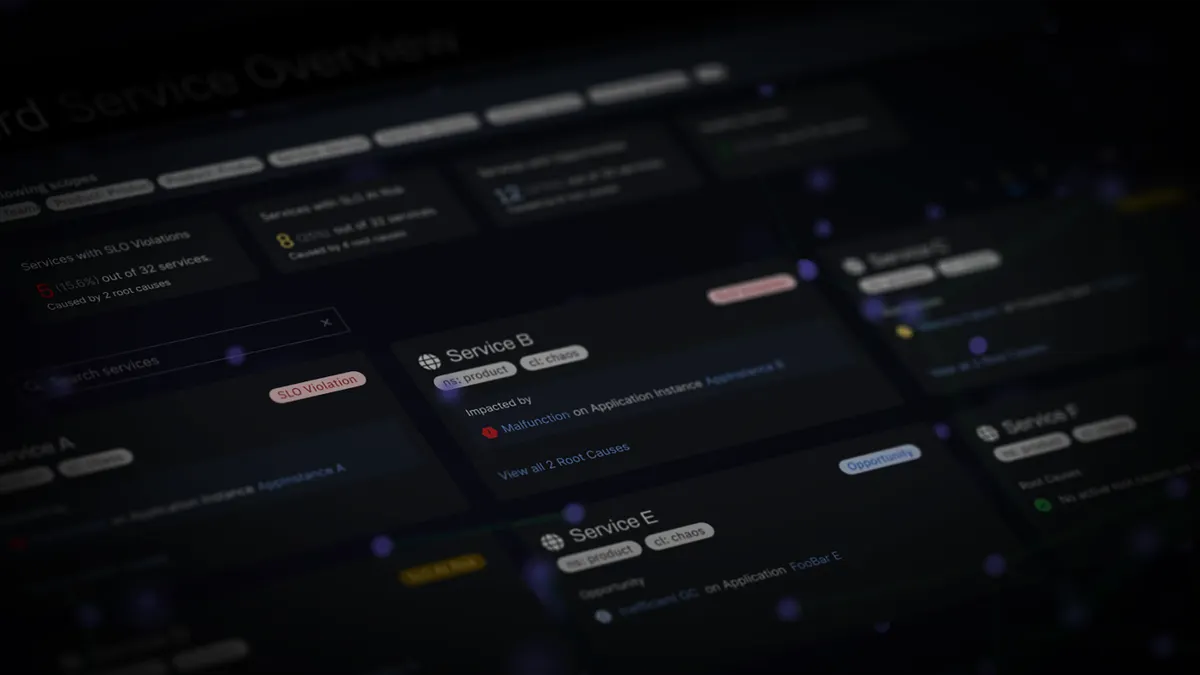Introduction
“AI SRE” – shorthand for applying artificial intelligence (AI) to Site Reliability Engineering (SRE) – has been bubbling up in conference talks, blog posts, and vendor marketing. SRE is a discipline that applies software engineering principles to ensure systems meet defined reliability targets. The idea of automating or augmenting this work with AI is compelling: fewer mistakes, less downtime, faster resolution, and lower cost. Not to mention, most engineering leaders would acknowledge a talent shortage in trying to fill these roles.
But the conversation is often fuzzy due to:
- A deafening level of marketing hype disconnected from reality.
- Varied understanding and adoption of SRE as a job function.
- Different interpretations and implementations of AI.
- Technology being implemented that is a poor fit for the task at hand.
In this article, I’ll strip away the buzzwords and define what I mean by AI SRE in precise, engineering-grounded terms. I’ll clarify how “AI” is being used today and what it should mean in the context of reliability engineering. From there, I’ll examine where it adds value, where it falls short, and outline a more effective starting point built on structured causal reasoning that can empower the safe and effective automation of reliability work.
SRE: One Discipline, Different Meanings
The SRE role traces its roots to Google in the 2000s, when Ben Treynor Sloss described it as “what happens when you ask a software engineer to design an operations function.” At its core, SRE is about taking accountability for reliability at a defined level that balances user and business needs while preserving engineering velocity.
To support this, the discipline introduced a set of practices that gave teams a measurable way to manage reliability: Service Level Objectives (SLOs) to make goals explicit, error budgets to balance those goals with the pace of change, and blameless postmortems to learn from failure. Automation followed as a way to reduce toil and eliminate human error. Together, these practices positioned reliability as an engineering problem rather than an afterthought.
However, in practice, many teams struggle to adopt these ideals. Reliability work often takes a backseat to feature delivery, and SLOs are often only partially implemented across sprawling microservices. What Google codified in its SRE handbook often reaches production environments as a patchwork.
Organizations also implement the role itself in different ways: embedded with product teams, focused on platform infrastructure, parachuting in as consultants, or owning services end to end. Most end up with some hybrid.
No matter the org structure or maturity, the discipline of reliability engineering is well understood: applying engineering principles to keep systems available, performant, and predictable. While the goals are clear, most engineering leaders would agree there is still plenty of room for improvement in practice.
What “AI” Actually Means
Before defining the ideal AI SRE, we need to clarify what “AI” means and how the term is used today.
In its original sense, Artificial Intelligence refers to systems capable of completing tasks that normally require human intelligence: reasoning, learning, problem-solving, perception, and natural language understanding.
Classical AI approached these challenges by decomposing complex tasks into structured representations of knowledge, explicit planning procedures, and inference engines that could compute outcomes from evidence. For example, building a diagnostic assistant for medicine required an ontology of diseases and symptoms, probabilistic rules for how symptoms map to likely conditions, and an inference engine to suggest tests or treatments based on the evolving patient state. Historically, AI has included:
- Rule-based systems
- Search and planning algorithms
- Probabilistic reasoning
- Constraint satisfaction
For deeper study, I recommend:
- Artificial Intelligence: A Guide for Thinking Humans – Melanie Mitchell
- Artificial Intelligence: A Modern Approach – Stuart Russell & Peter Norvig
- The Book of Why – Judea Pearl
- Judea Pearl on Cause and Effect (Sean Carroll Podcast)
These systems performed well when the domain was well defined and the relationships between causes, observations, and interventions could be explicitly modeled. But they broke down when faced with ambiguity, missing context, or natural language.
In common usage, “AI” today typically refers to large language models (LLMs), and in some cases, smaller-scale variants known as small language models (SLMs). These models generate language by predicting the most likely next word given the previous context, using patterns learned from massive training datasets. They have become popular because they handle a wide range of natural language tasks with impressive fluency, such as text generation, summarization, question answering, and code completion.
But while language models are effective at producing language and code, they have no inherent understanding of system state, live telemetry, or causal dependencies.
Why Language Models Are the Wrong Starting Point for Reliability Engineering
Reliability engineering requires exactly this kind of causal reasoning, which is why language models alone are the wrong foundation. The irony is that in its foundational sense, AI is a natural fit for reliability engineering: diagnosing outages, predicting failures, and recommending fixes are structured decision problems that align well with decades-old AI techniques. But when “AI” is reduced to LLMs and SLMs, the fit becomes like shoving a square peg through a round hole.
Surveying the market, most self-proclaimed AI SRE approaches fall into one or more of these categories:
- Postmortem narratives – After-the-fact write-ups shaped as much by bias as data, crafted to explain what went wrong in hindsight.
- Correlation engines – Systems that surface co-occurring anomalies and related events during incidents but conflate correlation with causation.
- Data-fetching assistants – Interfaces that summarize telemetry and suggest plausible explanations without guarantees they are correct or verifiable. Some resemble traditional automation engines, requiring heavy setup in data formatting, rules, and conditions before delivering value.
When language models are used as the foundation for reliability engineering, four weaknesses undermine their effectiveness:
- Spurious causes – Coherent but incorrect diagnoses from hallucination, logical inconsistency, or lack of live-environment awareness.
- Unprincipled reasoning – Mimicking the language of reasoning without performing structured inference.
- Causal identification failures – Difficulty pinpointing causes in dynamic systems, especially when new evidence contradicts learned assumptions.
- Runaway costs – Without precise prompting and context, LLMs consume large amounts of compute to generate answers that may still be inaccurate.
For reliability engineering, starting with a language model is starting in the wrong place. These approaches assume you already know which signals are worth chasing, when in reality multiple noisy alerts often trace back to a single root cause. Without causal reasoning at the foundation, both humans and AI waste time chasing symptoms instead of causes. Whether you are building internally at enterprise scale or looking for an off-the-shelf capability, any viable AI SRE must begin with causal analysis as its core.
What Effective AI for Reliability Engineering Looks Like
An effective AI SRE isn’t just a chatbot or a rule engine. It’s a framework that combines structured causal knowledge, probabilistic inference, and agentic capabilities. This foundation enables advanced reasoning and supports automation of real reliability engineering work.
Such a system needs at least three interdependent capabilities:
1. A live causal representation of the environment
A domain-specific causal model that encodes how components in a distributed system can fail, how those failures propagate, and the symptoms they produce, paired with a continuously updated topology graph showing the real-time structure of services, infrastructure, and their interconnections.
Why it matters: Replaces fuzzy LLM pattern-matching with a verifiable system map, enabling deterministic reasoning.
Counter to LLMs: Addresses unprincipled reasoning by grounding analysis in a causal Bayesian network that models directionality as probabilities.
Example: The model knows that a latency spike in a database layer can propagate through dependent APIs three layers away and can quantify that likelihood based on current conditions.
2. Real-time probabilistic inference over live telemetry
Continuous ingestion of metrics, traces, and logs, mapped against the causal model to identify the most likely root cause at any given moment. This inference layer reflects both structural dependencies and observed patterns of failure propagation, updating conclusions the instant new evidence arrives.
Why it matters: Dynamic systems change fast, with new code, new dependencies, and shifting load. LLMs cannot adapt without retraining, while a probabilistic inference engine adjusts instantly.
Counter to LLMs: Addresses causal identification failures, especially in counterfactual scenarios where new observations contradict prior assumptions.
Example: If a new deployment creates a previously nonexistent dependency, the model incorporates it into its reasoning immediately, without new rules or configs.
3. Cross-attribute and cross-service dependency reasoning
Beyond linking causes to symptoms, the system maps how performance attributes such as latency, throughput, and utilization depend on one another across services and infrastructure layers. By modeling these relationships, it can trace how a change in one part of the system cascades elsewhere, identify emerging bottlenecks, and detect when operational constraints are at risk. An added benefit is a sharp reduction in alert fatigue, because by isolating the true point of failure, only the responsible service owner is notified rather than multiple teams chasing downstream symptoms.
Why it matters: Many incidents stem from chains of interdependent changes, not a single fault. Modeling these relationships eliminates blind spots and false leads.
Counter to LLMs: Addresses spurious causes by ruling out explanations that violate known constraints or dependencies.
Example: If a queue length increase is due to a downstream service slowdown rather than local CPU saturation, the model identifies the real cause directly.
Either way, the same foundation of causal reasoning, probabilistic inference, and dependency modeling is required. With that foundation in place, language models finally have a meaningful role to play.
The Role of Language Models in an Effective AI SRE
Earlier, I noted that large and small language models can add value to reliability workflows. When provided with the right context, they can help accelerate diagnosis, generate remediations, and improve resolution timelines. But on their own, they lack causal understanding. Without grounding in system state and structure, even the most advanced model tends to produce responses that are plausible but operationally useless.
Modern AI SRE solutions must transcend summarizing symptoms or correlating metrics. To truly support autonomous site reliability, they must be able to understand complex IT environments, reason over live telemetry, and intervene intelligently to maintain SLOs and keep services healthy. AI for SRE should not be defined by language generation alone. It must include:
- A continuously updated causal model of the environment
- The ability to perform probabilistic inference over live telemetry
- The capacity to reason across attributes, services, and dependencies
- An agentic interface that can propose or execute safe and effective actions
Taken together, these capabilities reframe AI SRE from buzzword to engineering discipline.
Conclusion
The conversation about AI SREs is too important to leave to buzzwords. “AI SRE” should not mean a chatbot guessing its way through your telemetry. Treating “AI” narrowly as LLMs or SLMs misses the chance to apply decades of proven AI techniques — causal reasoning, probabilistic inference, and constraint satisfaction — to one of the highest-impact opportunities in modern software engineering: autonomous service reliability.
The future of AI SRE will not be built on pattern-matching language models alone, but on systems that can reason causally about live environments and adapt in real time. Language models then become a powerful augmentation layer. Without that foundation, AI SRE is just another buzzword.
Whether you are an enterprise building internally and looking to integrate causal reasoning into your architecture, or a mid-market company that needs a turnkey solution, the same principle applies: causal reasoning must come first. At Causely, we provide the flexibility to address both situations - a platform that can serve as a foundation for your own build, or a ready-to-deploy solution that works out of the box.










